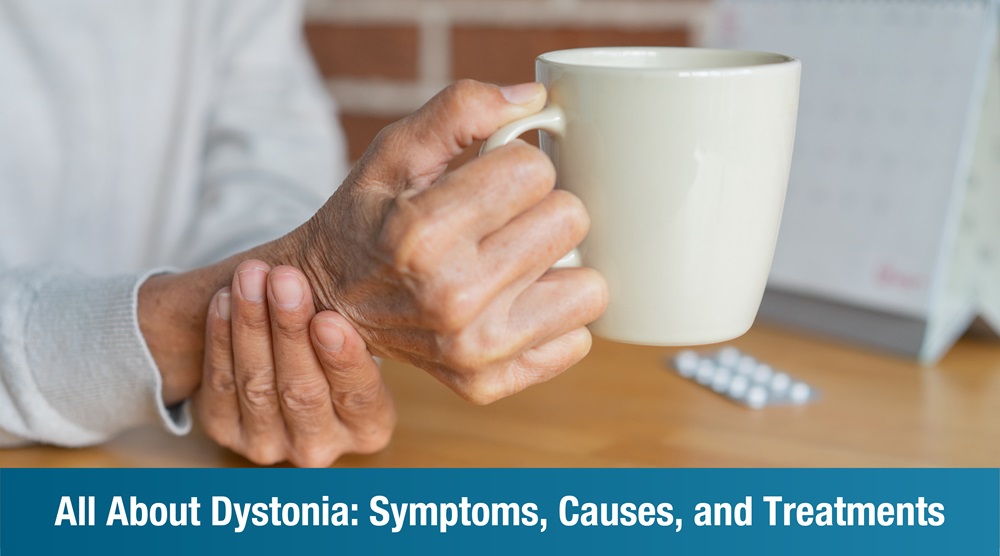
Dystonia is a movement disorder characterized by involuntary muscle contractions that cause repetitive or twisting movements. These contractions can be painful and may result in abnormal postures. Dystonia can affect any part of the body, including the neck, face, and limbs, and can occur in people of all ages. The severity of dystonia can vary from mild to severe, impacting daily activities and quality of life.
Symptoms of Dystonia
The symptoms of dystonia can differ depending on which muscles are affected. Common dystonia disease symptoms include:
- Cramping in the foot or hand: This may initially be mild but can become more severe over time.
- Pulling in the neck: This can lead to abnormal head postures, known as cervical dystonia.
- Involuntary blinking or eye movements: This type of dystonia, called blepharospasm, can cause the eyes to close involuntarily.
- A ‘dragging’ sensation in the leg: This can interfere with walking and other movements.
- Speech difficulties: Dystonia can affect the muscles involved in speaking, leading to slurred or unclear speech.
In addition to these physical symptoms of dystonia, individuals often experience pain or exhaustion. Fatigue can exacerbate the symptoms, and the condition can lead to depression or social withdrawal due to the stress it causes.
Types of Dystonia
Dystonia can be classified based on the affected body parts or its patterns. Here are some common types of dystonia:
- Generalized Dystonia: Affects most or all of the body.
- Hemidystonia: Affects the arm and leg on the same side of the body.
- Segmental Dystonia: Affects adjacent body parts.
- Focal Dystonia: Affects a single body part.
- Multifocal Dystonia: Affects more than one unrelated body part.
Some specific forms of dystonia, which can be considered syndromes in their own right, include:
- Cervical Dystonia (or torticollis): Affects neck muscles, causing the head to be pulled backward, forward, or twisted.
- Oromandibular Dystonia: Affects the lip, tongue, and jaw muscles, leading to difficulty speaking and swallowing.
- Cranial Dystonia: Affects the muscles of the face, head, and neck, often flaring up during specific tasks.
- Blepharospasm: Affects the eyes, causing uncontrolled blinking and potentially leading to the eyes being almost permanently closed.
- Paroxysmal Dystonia: Affects the body only during episodes.
- Spasmodic Dystonia: Affects the speech muscles in the throat.
- Torsion Dystonia: A rare, severe form affecting the entire body.
- Tardive Dystonia: A treatable form that occurs as a reaction to certain drugs.
Causes of Dystonia
Dystonia results from a problem with how nerve cells in the basal ganglia, the part of the brain that initiates muscle contractions, communicate. The causes of dystonia can be idiopathic (unknown) or acquired from various factors such as:
- Stroke: Interrupts blood flow to the brain, potentially damaging areas responsible for muscle control.
- Tumor: Can press on or damage parts of the brain involved in muscle movement.
- Brain trauma: Injuries to the brain can disrupt normal neural communication.
- Infections: Certain infections can affect the brain and lead to dystonia.
- Neurological conditions: Diseases like Multiple Sclerosis or Parkinson’s Disease can cause dystonia.
Researchers are also investigating genetic mutations that may lead to dystonia. A complete medical history and various tests are performed by doctors to pinpoint the exact cause of the condition.
Dystonia Treatment
Managing dystonia involves a multifaceted approach that may include several different types of treatments:
- Physical Therapy: Combines strength and stretching exercises to ease muscle pain and improve the range of motion.
- Cell Therapy: Aims to repair damaged cells, reduce inflammation, and modulate the immune system.
- Medications: Can be injected directly into the muscles to reduce contractions or taken orally to target neurotransmitters in the brain.
- Deep Brain Stimulation: Involves transmitting electrical impulses to the brain to alleviate muscle contractions.
- Speech Therapy: Helps improve communication if dystonia affects the throat, lip, tongue, or jaw muscles.
- Occupational Therapy: Assists patients in performing daily tasks more effectively, often with the use of aids.
- Selective Denervation Surgery: May be recommended to cut off the nerves involved in muscle spasms if other treatments are ineffective.
Dystonia can be challenging to manage, but with the right treatment, individuals can lead active and fulfilling lives. It’s important to remain patient and diligent with prescribed therapies and exercises. Over time, these efforts can significantly improve symptoms and enhance overall well-being.
To understand more about our rehabilitation for dystonia, please reach out to Team Plexus today.
WhatsApp +91 89048 42087
Call +91 78159 64668 (Hyderabad) | +91 82299 99888 (Bangalore)
FAQs
Is dystonia a mental disorder?
Dystonia is a neurological disorder, not a mental illness. It involves involuntary muscle contractions due to disruptions in brain communication, not psychological factors.
What is the root cause of dystonia?
The root cause of dystonia often involves abnormalities in how nerve cells communicate in the basal ganglia of the brain. It can be idiopathic or secondary to factors like stroke, brain injury, or genetic mutations.
Does dystonia ever go away?
Typically, dystonia does not completely go away. However, its symptoms can often be managed effectively with treatments like medications, physical therapy, and deep brain stimulation.
Is dystonia brain damage?
Dystonia itself is not brain damage. It is caused by abnormal brain function, particularly in the basal ganglia. It is a disorder of brain communication rather than physical brain damage.










